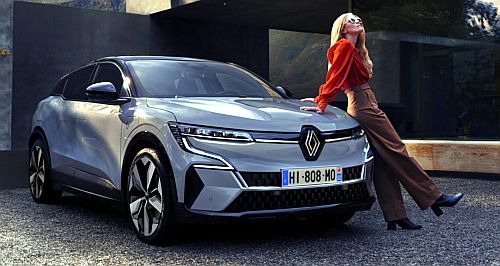Renault prepares for busy product rollout

RENAULT has a busy year ahead in Australia, with at least three models confirmed and more on the way.
The brand has just released its Megane E-Tech battery electric vehicle (BEV) and has two variants of the new-generation Kangoo small van coming, the E-Tech BEV arriving first in March and with a 1.3-litre turbo-petrol version later in the year.
A facelifted Captur light SUV may also arrive by the end of the year, although that could be delayed until 2025. Further out, the retro-styled Renault 5 E-Tech light BEV hatch and budget-conscious Dacia Duster small SUV are also high on the to-do list for the French car-maker’s local distributor.
Speaking to GoAuto at the Megane E-Tech launch in Sydney last week, Renault Australia general manager Glen Sealey said that the brand was gearing up for a number of new product arrivals during the coming 12-18 months.
“We’ve got plenty on; it’s a full dance card for us. Since we took over in 2021, until now we’ve only brought in a facelifted Trafic (mid-size van), so it’s good to see some new product coming in.”
First up is the Megane E-Tech, which has arrived this month as an all-important player in the small electric SUV segment. While available here only in a more premium Techo 60kWh variant, Mr Sealey said the range might be broadened later.
“We’re happy with this variant, the Techo; later on we may look at additional variants. We want this variant to settle down over a year or so first,” he told GoAuto.
Although Mr Sealey would not talk on Megane E-Tech sales volumes, he was hopeful of good demand if the market remains relatively stable.
“We see good volume potential for this vehicle, but we’ll see how it goes. There’s plenty of things happening in the marketplace that could alter demand; we’ve got regulations that could be in play in 2025; a whole host of things happening in the marketplace that could affect demand on a vehicle like this. It’s not a normal marketplace to pick upon.”
The regulations that Mr Sealey referred to were new federal emissions and fuel efficiency rules due to be enforced for new vehicles from next year.
While he declined to respond in detail on Renault’s position regarding the introduction of these regulations, he said the brand was “well-placed for this”.
“We’ve got two EVs and the rest (of the range) has reasonable emissions.”
The Kangoo E-Tech arrives next month priced from $61,990 before on-road costs, with short or long-wheelbase offerings powered by a 90kW motor and with 285km WLTP range from the 45kWh battery pack. A less expensive Kangoo 1.3 petrol will also be offered in short- and long-wheelbase in coming months.
As for the Captur facelift, Mr Sealey said Australia was “still a long way from that car”.
“With production as it is today, probably at the beginning of next year.”
Meanwhile, there are other products that Renault Australia would like to see on sale here such as the Renault 5 E-Tech, an upcoming BEV to commence production this year that employs retro styling reminiscent of a model sharing the same name that sold in two generations in overseas markets between 1972 and 1996.
Mr Sealey was enthusiastic about having the Renault 5 E-Tech on sale in Australia. “Renault 5 is a car we would be very excited about, I think it would work quite well here. We’ve been clear that’s a vehicle we would like, but now have to go through the normal business case study.”
As for the prospects for a low-cost BEV such as the Dacia Spring, Mr Sealey said it was not on the cards locally -- for now, at least. “Today in Europe there is a very good value-based car in the Renault group called Dacia Spring, but today the business case wouldn’t stack up for Australia.”
Meanwhile, the Dacia Duster has been a small/medium SUV on the local Renault business radar for some time. When asked if this on again, off again model would ever arrive here, Mr Sealey responded “Dacia has always been on, never been off for Australia.
“Duster is absolutely on our radar, although it would be under the Renault brand, as it is in some other markets. The Duster is a very strong chance in Australia, under the Renault brand, but not this year. It’s a product that would work very well for this market,” he said.
“While nothing is ever guaranteed, that is a vehicle that we would be very happy to have on our shores as the Renault Duster.”
While Mr Sealey would not comment on any future prospects for Renault Australia’s most popular model, the Koelos, he did say “[The Duster] would not replace Koleos, it’s a different car to Koleos”.
Although reticent to talk about any other furture product, Mr Sealey said, “We’re working on more electric vehicles, certainly in the next three years.
“My normal line is, if it’s available in right hand drive, and it stacks up as a business case and for the customer, we’ll bring it in. From our perspective, any vehicle has to be made available to us, its business case has to stack up. It has to make sense for Renault, it has to make sense for us and most importantly it has to make sense for the customer here in Australia.”